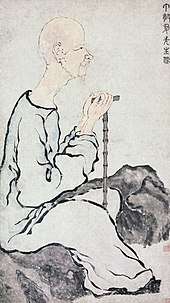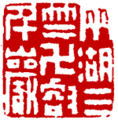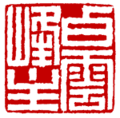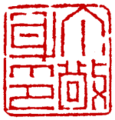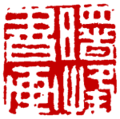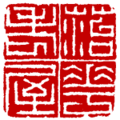Ding Jing
Ding Jing (Chinese: 丁敬) (1695–1765), aka Ding Jingshen was a Chinese seal carver.
Ding was born in Qiantang (now Hangzhou). His earlier works show the influence of Wen Peng and He Zhen[1], but he soon developed his own style and together with several of his students founded the Zhejiang School (or simplye Zhe School) of seal carving.[2] This style of carving focused on revitalising the art by adopting older, simpler Han dynasty characters. His founding of this school made him the most notable seal carver in Qiantang, and the school itself was patronised by courtiers such as Ruan Yuan and Weng Fanggang.[3][4] Together with the seven students who helped him create the school (these being Jiang Ren (蒋仁), Huang Yi (黄易), Xi Gang (奚冈), Chen Yuzhong (陈豫钟), Chen Hongshou (陈鸿寿), Zhao Zhishen (赵之琛), and Qian Song (钱松)), Ding was known as one of the Eight Masters of Xiling.[5]
As well as the scholars noted above, Ding Jing was also a close associate of the painter Luo Ping, and carved a number of seals for him.[6]
Examples of seals by Ding Jing
References
- Kecheng Niu (2008). Chinese Seals. Foreign languages Press. ISBN 978-7-119-04197-1.
- Weizu Sun (2004). Chinese Seals: Carving Authority and Creating History. Long River Press. pp. 60–. ISBN 978-1-59265-013-2.
- Yeh, Ch'iu-yuan. "The Lore of Chinese Seals". China Heritage Quarterly. Retrieved 12 June 2017.
- Yulian Wu (2017). Luxurious Networks: Salt Merchants, Status, and Statecraft in Eighteenth-century China. Stanford University Press. pp. 112–. ISBN 978-0-8047-9811-2.
- Jason C. Kuo; Jisheng Guo; Peter Charles Sturman (June 2003). Double beauty: Qing dynasty couplets from the Lechangzai Xuan Collection. 香港中文大學文物館. p. 256. ISBN 978-962-7101-64-2.
- Kim Karlsson; Alfreda Murck; Michele Matteini (2009). Eccentric Visions: The Worlds of Luo Ping. Museum Reitberg Zürich.
